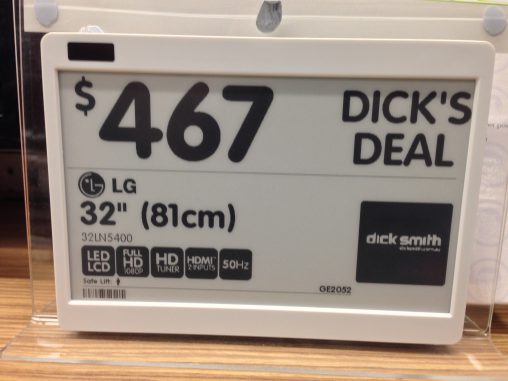Retailers looking to throw away the texta and scrap paper and move into the world of 21st Century labels and shelftalkers should consider esLabels for digital in-store pricing, according to marketing manager Ruth Hurley.
While the old format is cheap, easy and familiar, often lending itself to clever communication a la JB Hi-Fi, electronic labels provide for instant control of pricing, evenly remotely, so managers and head office staff can immediately push price changes based on competitor activity, market forces or personal whims.
“It’s amazing really that in this day and age most stores still use such an archaic and manual system to display their prices,” Hurley said. “In a world where augmented reality is a staple in most marketing strategies, 3D printers can create human body parts and a virtual currency can exist, why are bricks and mortar retailers still spending resources printing and changing product price labels by hand?”
Those still using an “archaic and manual” system might argue that it is still easier to scribble a price on a piece of paper that log into a computer program, while other retailers might say that they don’t want to surrender control of pricing to a head office overlord. That said, Hurley does have a point when discussing the broad flexibility provided by electronic price tags.
esLabels is based in St Leonards, in Sydney’s northern suburbs, and services all of Australia. Hurley told me its services are ideal for for any bricks and mortar retailer that changes product prices weekly or more frequently, from a single store all the way up to a national chain. She said esLabelswas currently in talks with several leading retailers for a widespread rollout, though she stopped short of naming any.
“Real-time pricing opens the door to a whole new realm of pricing strategies aimed at optimising sales, such as time or event-based pricing. For example, a retailer can respond to a competitor price change almost immediately. It’s perfect for any retailer that holds a range of products that change in price frequently, especially franchises or retailers that have a large network of stores.
“Internationally it’s proven to be highly successfully for electronics stores.”
Dick Doesn’t Deal

In January 2014, Dick Smith trialed E Ink electronic price tags in one of its outlets. E Ink is the display technology used in early model Kindles that did have not have backlighting. Although easy to read and dynamic, Dick Smith abandoned this trial and returned to paper price tags shortly afterwards. A spokesperson at the time told me:
“Dick Smith trialed this method in one store to investigate any benefits it provided regarding time efficiency and paper wastage. Dick Smith will not be continuing with this method in this store, or any additional Dick Smith stores.”

